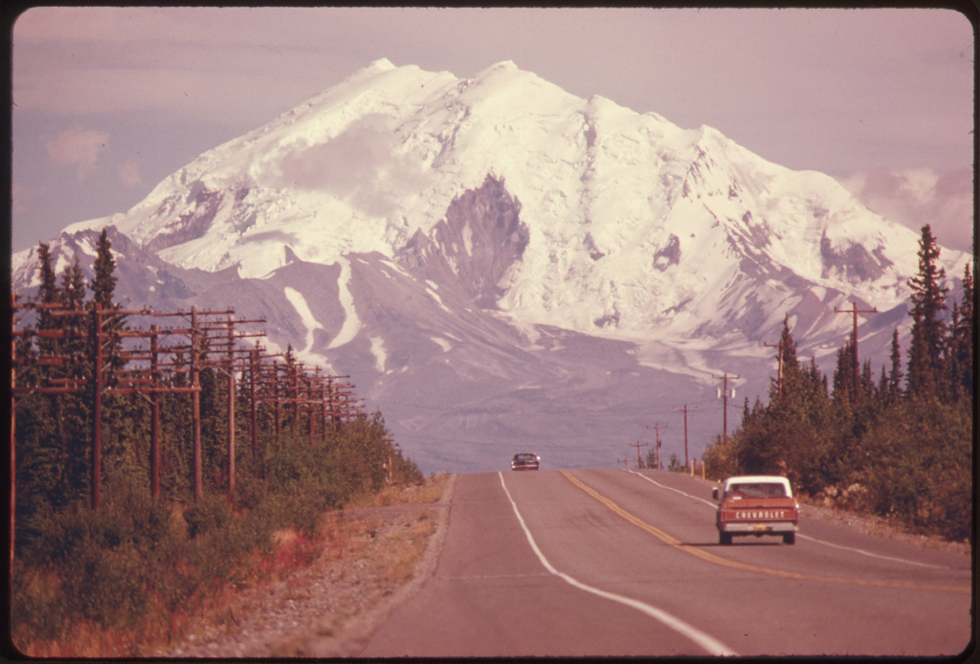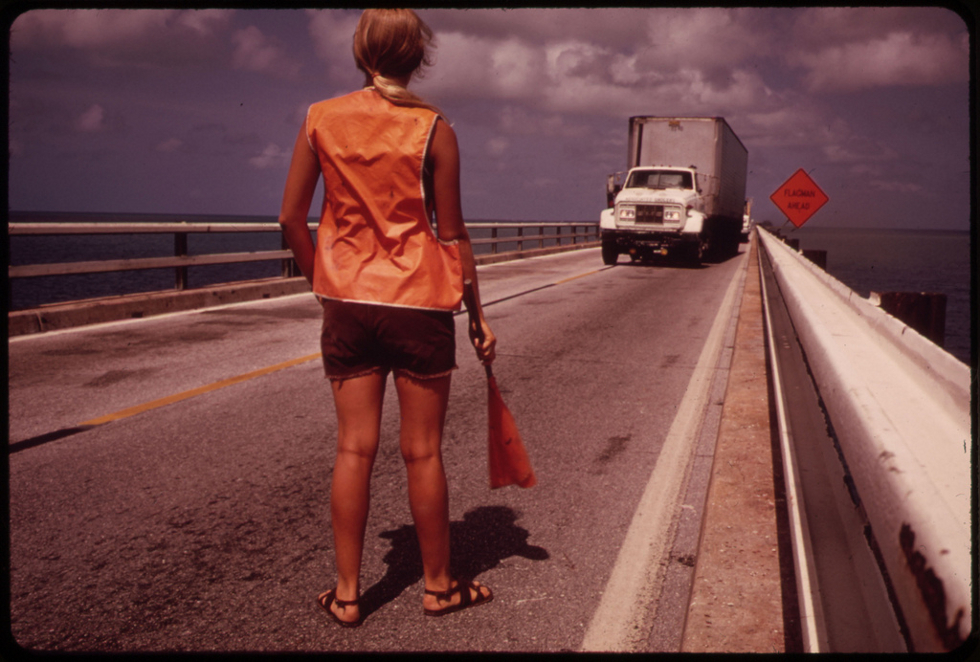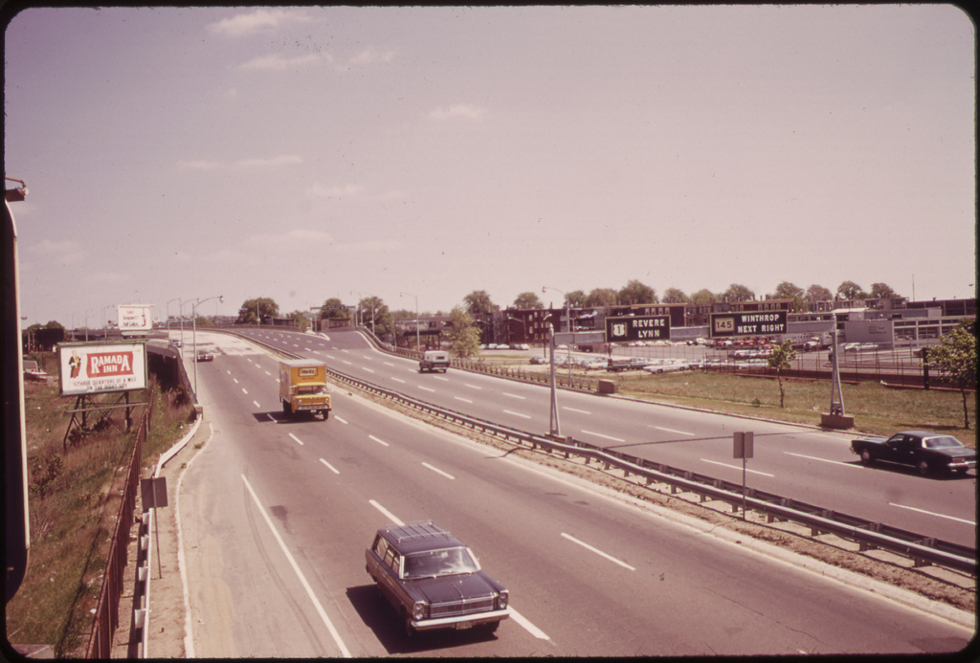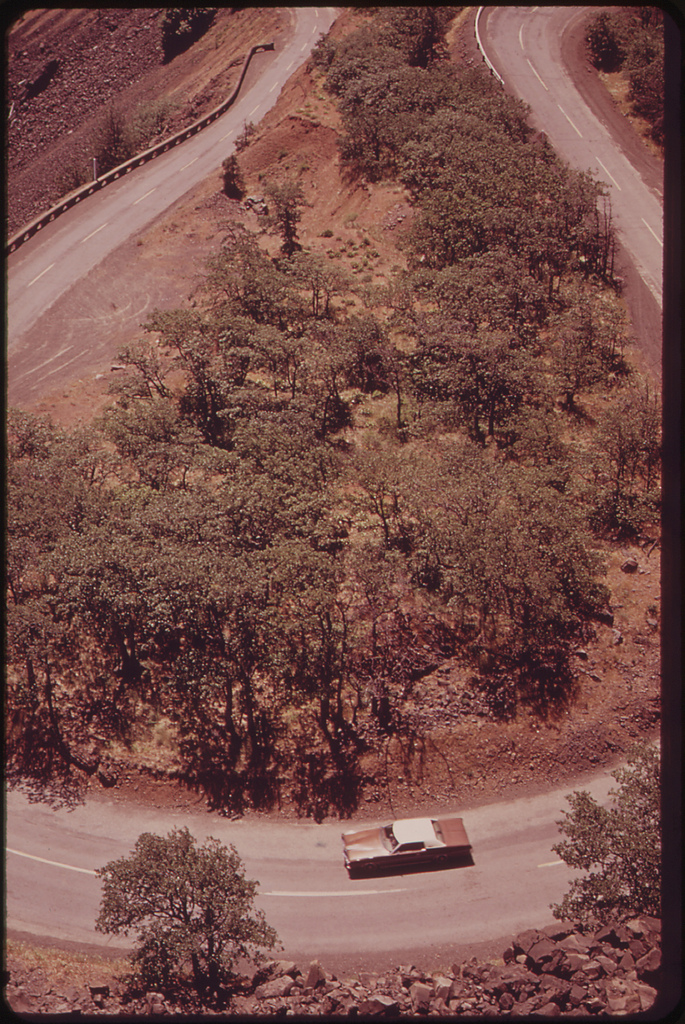highway
by Chip Callahan

I’ve been havin’ some hard travelin’, I thought you knowed.
— Woody Guthrie, “Hard Traveling”
I’ve been hittin’ some hard travelin’ too.
— Bob Dylan, “Song for Woody Guthrie”
In the summer of 1978, after planning and saving for years, my whole family packed into an Itasca motorhome and spent six weeks driving a loop around the country, heading south from the Boston area on I-95, then west on I-40 (or was it I-70?), out to California, then back on the northerly I-90. I was ten years old, and the trip was more than a touristic venture to me. It was discovery on multiple levels. It was, in some sense, “the quest,” a term that I would later find helpful when I watched The Power of Myth, Bill Moyers’ series of interviews with Joseph Campbell, on PBS. It was history and myth come alive as we drove, walked, and slept in places we’d heard and read about, inhabiting stories in a material way. It was the sense of freedom of movement, and freedom from abstract responsibilities beyond the practical needs of the day. It was a process of self-discovery in every encounter with people, things, sounds, smells, sights, ideas, and stories that had not otherwise figured directly in my daily life at home.
For years after that summer the highway figured strongly in my imagination. I dreamed of living in a motorhome or a van, something mobile with a sense of self-sufficiency. By the time I was in college the American highways’ promises of adventure and freedom took another tangible shape in the form of Grateful Dead concert tours. Here, thousands of relatively like-minded Deadheads pictured America as a network of roads connecting nodes of familiar gathering sites that were the regular seasonal stops of the band that gave them an identity that was simultaneously deeply American (and tied to an American mythos) and yet an alternative to the American mainstream. Dead shows were places of experimentation, expression, and learning with a particular emphasis on the relationship between individuality and community. The unusual form of Deadhead community—only coming together physically periodically and temporarily, and never the same in each case, while simultaneously imagined as stable and lasting over great distances—was, it seemed to me, much like the sense of America that I had formed in my earlier highway travels. Shared roads, shared landscapes, shared experiences, and the shared stories brought the disparate together into some form of unity—or perhaps what Victor Turner meant by “communitas.”
When I graduated from college, by then a veteran of Dead tours, I had one thing on my mind. I packed up my Volkswagen bus and headed out on the highway with no particular destination in mind. I lived in that bus for months, driving wherever my whims took me. I was discovering America, and in the process discovering myself. Or, more accurately, the America that I came to know and study and the self that I became were co-constituted by the highway.

On the road again –
Just can’t wait to get on the road again.
— Willie Nelson, “On the Road Again” (1980)
The highway, for me and for my fellow Deadheads, as well as for countless other individuals and communities, has been a quintessentially American spiritual technology of the twentieth century. As both symbol and concrete (or asphalt) reality, as metaphor and metonym, the highway has figured deeply as a space of freedom, transformation, discovery, individualism, danger, hope, and new beginnings. Though a twentieth-century development, the highway’s spiritual roots lie further back in the seafaring trajectories of the European pilgrims and entrepreneurs who saw in their westward movements and explorations the possibilities of fulfillment of purpose and discovery. Ever since, the frontier and pioneers have defined at least one vector of the American Dream. From Mormons to missionaries, speculators to homesteaders, natives to immigrants, movement across the American continent has been an essential element of the American soul.
A thorough study of highway spirituality would also have to include formative roots in Transcendentalism and the Romantic painters of the Hudson River School, among other American imaginaries that identified God in nature and, especially, in the abundant American landscape. The nation’s traditional tension between wilderness and technology, described aptly by Leo Marx in The Machine in the Garden, finds a dialectic still point (or is it a monstrous energy?) in ribbons of asphalt upon which people drive to connect to the American land. In what amounts to a material form of Zen koan, highways are the connecting arteries between National Parks, which are sites of deep spiritual resonance for many who travel great distances for the chance to walk and drive through protected nature. As I understand it, the “spirituality” evoked, provoked, or invoked by the highway is tied to the particular cultural and social history of the United States that provides the stories, characters, events, metaphors, and resonances making up a spiritual idiom that merges with (and emerges from) the languages and experiences of physical mobility.
Life is a highway
I want to ride it all night long
— Tom Cochrane, “Life is a Highway” (1991)
Although “spiritual” is so often cast as the antonym to “material,” any consideration of the venues, forms, and technologies of spirituality in America quickly must concede matter’s inescapability. In the case of the highway, the material produces the spiritual by laying down the grooves of physical space to be traversed, again and again, adding layers of experience, legend, myth, and memory over time. To travel the highway for any substantial distance is to move through space that is occupied by a century of ghosts, each moving through that space similarly, along the same trajectories, passing through the same landscapes and towns and crossing the same rivers and mountains. Moreover, those ghosts have stories—stories that have shaped and been shaped by a particularly American sense of authenticity and liberty. Spirituality here means a sense of getting to the real by stripping away the conventional, staying on the move to slip out of the confines of being pinned down by the stasis of habit. The authenticity and spirituality of the road is premised on the idea that the real is elsewhere, or can be reached by leaving the familiar behind. The highway is the space of potential, not here nor there: it is liminal. A “temporary autonomous zone.”
When travel writer William Least Heat Moon decided to drive the nation’s “backroads” highways that meandered through small towns and “real” America detailed in his classic Blue Highways, he thought that “Maybe the road could provide a therapy through observation of the ordinary and obvious, a means whereby the outer eye opens an inner one.” Maybe it could. At the very least, it might set things in motion and materialize the spirit of American dreams. More than simply a means of convenient transportation, the highway has held out this promise as a significant spiritual technology throughout its American history.
Oh God said to Abraham, “Kill me a son”
Abe says, “Man, you must be puttin’ me on”
God say, “No.” Abe say, “What?”
God say, “You can do what you want Abe, but
The next time you see me comin’ you better run”
Well Abe says, “Where do you want this killin’ done?”
God says, “Out on Highway 61”
— Bob Dylan, “Highway 61 Revisited” (1965)
Highway 61. U.S. Highway System (1924). The Interstate Highway System (1956). Route 66. Highway 1. The 101. 95. The names and the routes, the movement through changing landscapes as the roads wind through the mountains and prairies, call to mind other movements and peoples who found hope and purpose, who sought adventure or rebirth on the highway. For me, those connections are visceral: the highway conjures Jack Kerouac’s Beats and Ken Kesey’s Pranksters, who in turn recited Woody Guthrie’s Okies and Utah Phillips’s Wobblies and hobos. Here is a history of an other America that nevertheless has been a defining American experience. These (and many more) mythic figures of American history took to the roads and rails in pursuit of American dreams of freedom and autonomy—ambivalently defined in material, social, psychological, political, or transcendent terms. The common thread was movement across the landscape, typically at one’s own pace and whims. And that movement produced encounters with self and with others in ways that spun out of the everyday into the extraordinary. Kerouac’s novels, for instance, documented continuous religious and spiritual learning from the strangers he met on the road. Kesey’s boundless utopianism and the Pranksters’ experiments with reinventing reality were fueled not just by LSD, but by the mobility of their psychedelic bus traveling the American highways.
But as with most mythic histories, the road’s realities have been far more complicated than the romanticized images conveyed by literature, film, and folklore. The highway’s movement is dynamic and polysemous, transformative in specific relation to the motivations and imaginations of those who travel it. For some, therefore, it is a space of leisure and adventure, a remove from the tediums and conformities of everyday life in the social/consumer/workplace rat-race. For others, it is a space of labor, whether driving a truck or itinerantly looking for a next paycheck, a way to get ahead or at least to keep afloat. For some it is an escape from a life best left behind, perhaps a chance for a practical rebirth, a new beginning in a new place. For others, it may be an extension of a life, or a temporary voyage of discovery with the promise of a safe and comforting return. In any case, the road journey is a passage through time and space that produces potent potential encounters with newness that might challenge the status quo and the everyday. The highway holds potential.
These two lanes will take us anywhere
We got one last chance to make it real,
To trade in these wings on some wheels.
Climb in back
Heaven’s waiting on down the tracks.
Oh oh come take my hand,
Riding out tonight to case the promised land,
Oh oh Thunder Road
— Bruce Springsteen, “Thunder Road” (1975)
A glance at the abundance of stories set on the highway in various genres of American popular culture illuminates the desires encapsulated, but also the tensions inherent, in this space of discovery and becoming. Bruce Springsteen knew the spiritual measure of the road and made it a staple of his songwriting toolbox. The highway, for Springsteen, was the Exodus path. The car was the vehicle to the Promised Land. As Kate McCarthy has explained, though, the highway to the Promised Land, while remaining a central metaphor, has changed texture and mood over the course of Springsteen’s career, from an early vision of escape from the boredom and meaninglessness of small-town, working-class New Jersey to a later criticism of America’s failure to live up to its promises.
The transformation from hope to tragedy is as familiar a theme in American popular culture’s depictions of the highway as its converse. From Easy Rider to Thelma and Louise, the quest for freedom through movement has often ended in death and despair. Or is it a radical form of freedom that these texts teach? Thelma and Louise certainly leaves the ambivalence open. So do, in their own way, Bonnie and Clyde, another American archetype of the highway that influenced these and other films such as Natural Born Killers. Such films and characters are a reminder that the highway is also the space of the outlaw, the bandit, represented by motorcycle gangs who take the liberty to live according to their own rules of honor and community outside of the laws of the nation-state (for instance, see The Wild One, Hell’s Angels on Wheels, and Smokey and the Bandit.) They are twentieth-century pirates, portrayed as dangerous but radically free and fundamentally fair within their own world. They serve, then, in pop culture, as a critique of the material and social inequalities and the structures of domination and oppression that belie the American Dream. For all of their danger, violence, and refusal of the legal and social norms that guide mainstream American life, these outlaws and their stories figure prominently in the nation’s folklore. Like the sacred itself, according to theorists of religion, they are both appealing and terrifying, attractive and repulsive. And this, too, is part of the mystique of the highway as a spiritual technology that has the ability to take travelers to the edges of experience.
I cannot help but think that much of the spiritual power of the highway stems from the multiple tensions and contradictions that it embodies: the highway is a space of desire and danger, of freedom and violence, of individual autonomy and communal connection, of promise and pitfall, of industry and nature, of self and other, of stability and transience, of potential and limitation, of dreams and dirt. The structure of contradiction itself embodies a particularly American, and particularly modern, antagonism. It should not go unnoticed, for instance, that this particular spiritual technology is also destructive of the American Dream, inherently taking part in the industrial production and sales of automobiles and the overuse of fossil fuels. As so often happens, the pursuit of freedom and the real comes with great costs and unforeseen consequences.
But out on the highway old stories are inhabited, new stories emerge, and they blend together like the blur of the passing landscape as it mixes with the music on the radio. Throwing off the everyday, entering into the space of discovery and adventure, opening up to whatever possibilities and experiences come into play, the highway traveler is born anew.


